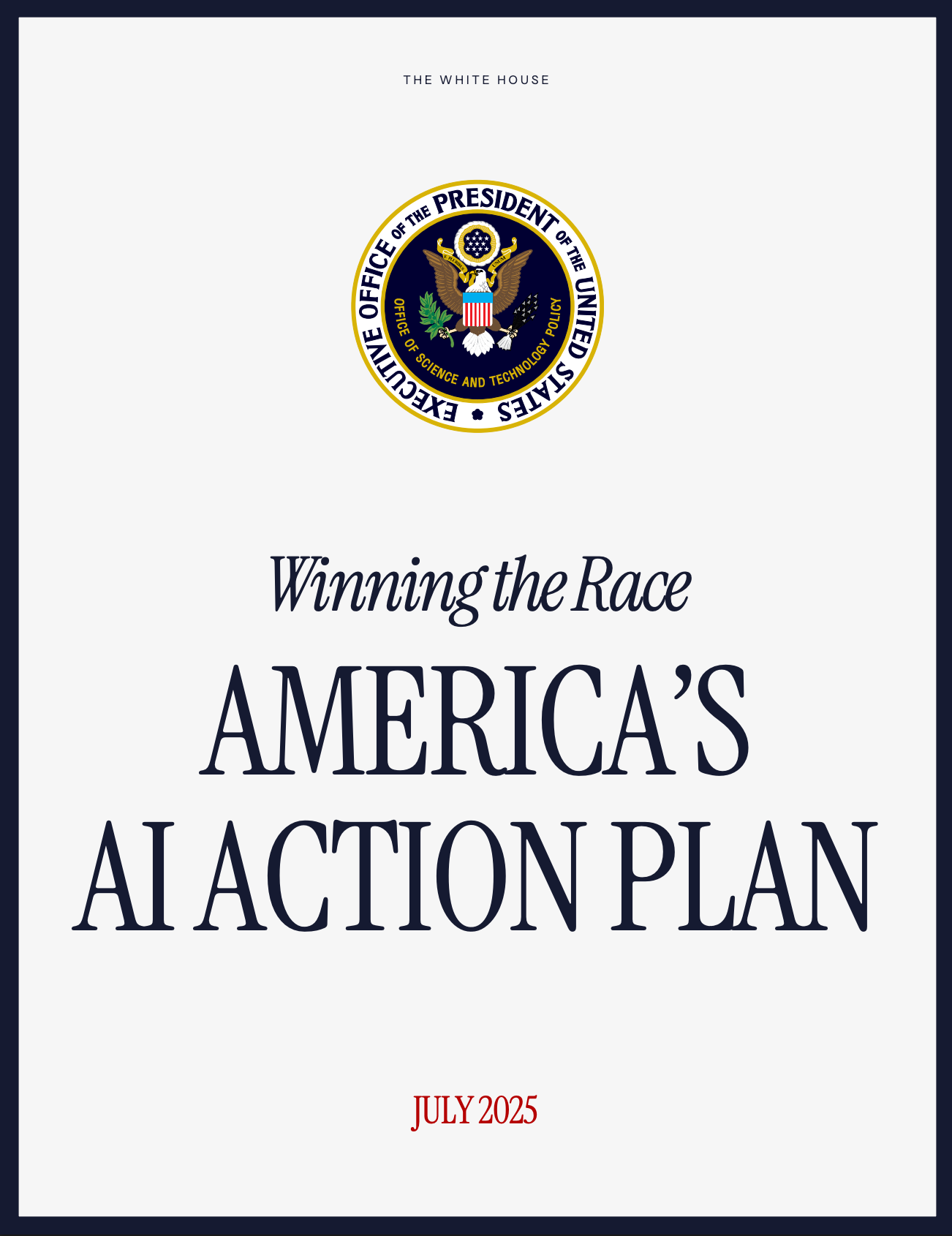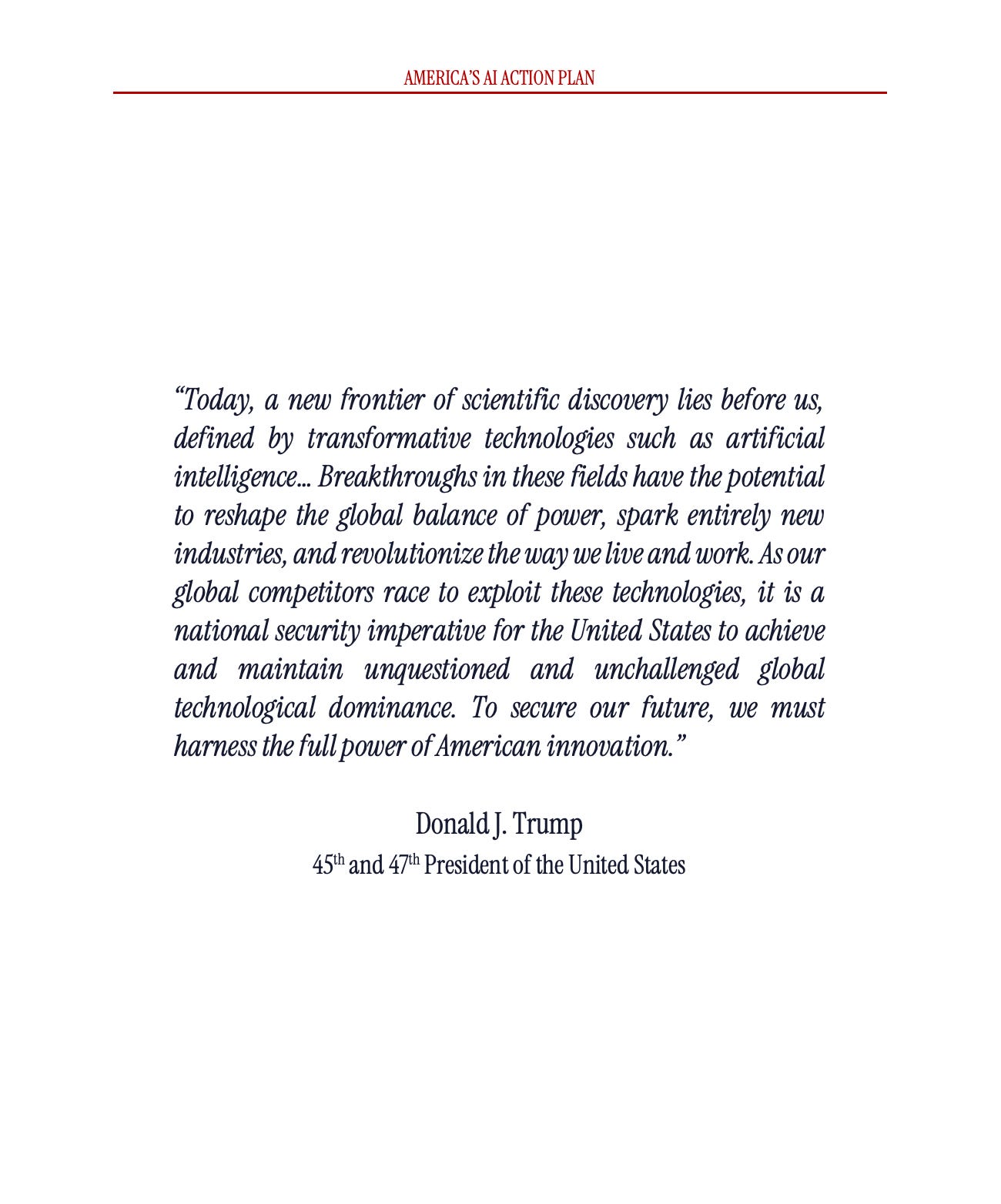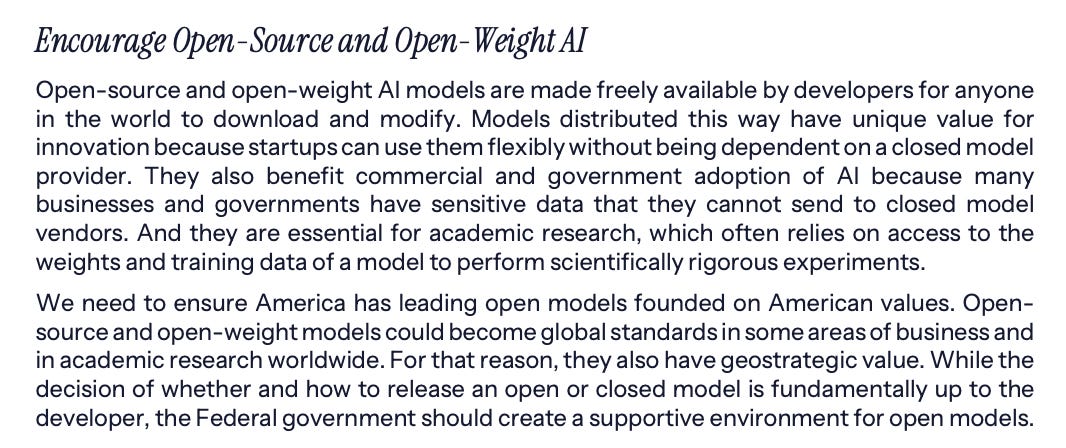Policy Update: The White House AI Action Plan
The Artificial Intelligence Action Plan: What it means for technology industry and policy
On 23 July 2025 the White House released the Artificial Intelligence Action Plan that focuses on innovation, infrastructure and international diplomacy. It sets out how the United States intends to lead in developing advanced AI systems, build the facilities and energy needed for them and strengthen global partnerships.
A New AI Action Plan from the White House
On 23 July 2025 the White House unveiled the Artificial Intelligence Action Plan.
It is presented as a decisive national roadmap and comes directly from Executive Order 14179 that required the government to dismantle barriers to American leadership in this area.

It carries with it an unmistakable message that the administration is intent on driving three interconnected priorities: innovation, infrastructure and international diplomacy.
The introduction of the plan begins with a stark description of competition. It recognises that the nation which builds the most extensive and dynamic AI ecosystem will set global standards and will hold advantages in economic growth and national security.
It treats this as a race that must be won.
The plan is unambiguous in its expectation that breakthroughs in these technologies can transform not just science but education, communication and defence.
The language throughout the document is deliberate.
It frames AI as a generator of new industries, scientific progress and a renewed industrial base.
There is also a strong emphasis on ensuring that the benefits extend to workers and families by linking innovation with high quality jobs and improvements in living standards.
The plan sets out a three pillar structure.
The first is innovation.
It promises to remove what are described as unnecessary and burdensome rules that obstruct experimentation and product development.
Federal agencies are instructed to find and revise regulations that slow adoption.
There is a specific insistence on protecting freedom of speech and on keeping the most advanced models free from ideological bias when they are procured for federal use.
The plan also expresses support for open models that researchers and start ups can access and adapt.
This is seen as a route to keep the country ahead scientifically and commercially.
The second pillar is infrastructure.
It places enormous weight on the creation of a physical and energy base capable of sustaining the growth of advanced computing.
There is recognition that the demand for energy and secure data centre capacity will continue to rise.
In response the plan seeks faster permitting, particularly for data centres and chip manufacturing plants.
It also makes clear that government policy will encourage the building of these facilities in a way that excludes foreign technologies regarded as risky.
The third pillar is international diplomacy.
The plan calls for the United States to export its systems, standards and computing technologies to allied nations.
It also includes commitments to strengthen export controls and to prevent the diversion of advanced computing resources to countries of concern.
There is a repeated theme that America must take a leading role in governance discussions and that it will resist efforts within global organisations to impose approaches that in the view of the administration restrain innovation or align with foreign adversaries.
Reading the document as a whole, the tone is resolute. It places national interest at the centre of every initiative and suggests that regulation must be guided by that priority.
Removing Obstacles to Innovation
The first of the three pillars of the Artificial Intelligence Action Plan focuses on clearing the ground for innovation.
It takes the position that rules and procedures built for another time have grown into barriers that slow private research and discourage new companies.
The plan speaks plainly about this.
It states that the federal government must not bury promising ideas under an excess of rules and that the private sector must be given the space to explore and build without interference.
This part of the plan draws a direct line from innovation to national strength.
Federal agencies are now directed to examine every policy, every memorandum and every administrative practice that may create obstacles to development in this area.
They are instructed to remove or revise them where they hinder new systems or tools.
The AI Action Plan sets an expectation that funding and support will not be given to projects in states that choose to impose unnecessary controls that make it more difficult to test or deploy these systems.
There is also a warning that federal resources will be allocated with careful attention to how each state treats this field, and that the climate for development will be a factor in future decisions.
The plan goes further by calling for a broad consultation with industry and the public.
This process will collect information about the specific ways in which regulations slow progress, and the answers will guide federal action.
Even investigative actions by the trade regulator are to be reviewed to ensure that they do not carry forward assumptions or legal theories that block innovation.
The AI Action Plan pays attention to the design of the systems themselves.
It states that these advanced systems, particularly those that use the largest language models, must be developed with an insistence on freedom of speech and the avoidance of any built in ideological direction when they are purchased by government agencies.
In this vision, neutrality and accuracy are seen as part of the national interest.
In this same spirit, the document turns to the place of open models.
These are the models that are made available to researchers, to universities and to small companies, giving them the ability to experiment and build without having to depend on a few large companies.
The plan recognises that such models are often the starting point for the next breakthrough.
For this reason, it sets out a series of actions that will make computing power easier to obtain for those who cannot afford long contracts with major providers.
It anticipates that through partnerships with the research community and through the work of the National AI Research Resource pilot, access to the high computing requirements for modern models can be widened.
These proposals are presented not as theory but as a call to action.
They include new funding channels, the creation of shared computing capacity, and the building of environments where start ups can test their work under the supervision of agencies that can give guidance rather than punishment.
The plan makes a particular point of ensuring that these measures do not only benefit commercial organisations but also the scientific community that depends on open access.
In reading this part of the plan, one can see a strong thread of policy direction.
The government intends to stand back from restrictions, to open its own systems to frontier models, and to use its resources to make sure that the benefits of these tools reach a wide range of institutions.
Expanding Infrastructure for the AI Era
The second pillar of the AI Action Plan is devoted to building the physical and technical foundations for an economy that is driven by these new systems.
The plan begins with a frank recognition that the country does not have the level of energy generation, data centre capacity or semiconductor manufacturing needed for what is ahead.
It makes clear that the response to this shortage cannot be delayed because every year of inaction risks losing ground to global competitors.
The plan sets out the way to accelerate the construction of data centres and semiconductor plants by making the approval processes faster and more predictable.
This involves new categorical exclusions within environmental reviews and an expanded use of the procedures in the Fixing Americas Surface Transportation Act.
These are presented not as technicalities but as essential changes to ensure that the projects that will support the growth of these systems are not slowed by long periods of review.
At the same time there is an insistence that these facilities must not include components or services from foreign adversaries. The security of the supply chain is treated as a national interest.
The document explains that the need for energy will grow dramatically as these systems become larger and more capable.
For that reason there is a plan to modernise and strengthen the electric grid so that it can provide reliable energy at the scale required.
The measures include keeping vital power generation facilities open, improving how the transmission network is used, and investing in new forms of energy.
These actions are described as the foundation of a grid that can grow with the demands of the technology rather than fall behind.
A significant part of the infrastructure strategy is to restore the country’s ability to manufacture semiconductors.
These chips are described as the essential part of modern computing and their production is treated as an issue of security as much as industry.
The plan is explicit in seeking to return these factories to American soil and to free them from requirements that slow their operation.
Special attention is also given to high security data centres that will be designed for the needs of the military and intelligence agencies.
These centres will handle sensitive information and will need to be resistant to the most determined forms of attack. Standards will be developed in cooperation with relevant agencies to guide their construction.
Finally, the plan turns to the workforce that will be needed to build and maintain this infrastructure.
It calls for a national programme that identifies critical occupations such as electricians, data centre specialists and other skilled trades, and creates pathways into these roles through education and apprenticeships. These initiatives are described as a way to prepare a generation of workers for the demands of this new era.
This part of the plan leaves little doubt that infrastructure will be treated as the foundation for everything else, and that investment, speed and security will guide how it is built.
Global Diplomacy and Technology Security
The final pillar of the AI Action Plan sets its sights far beyond the American mainland.
It is here that the plan outlines a vision of a global network that runs on American built models, hardware and standards, with a focus on allies who are prepared to work under the same security commitments.
At the same time it seeks to prevent strategic rivals from gaining ground through influence or diversion of technology.
The plan describes an active programme to export the full range of American systems, from semiconductors to software, to those countries that are willing to become part of a common alliance.
It sees the spread of American systems as a way of reducing dependence on technologies that could be used by adversaries to exert pressure. This is not framed as charity.
It is a deliberate policy to maintain leadership by ensuring that allied nations do not have to turn elsewhere when they build their own capacity.
The plan also anticipates coordinated packages of support where companies and agencies will work together to deliver secure systems to partners abroad.
There is a clear sense in the document that international standards bodies and global organisations have become a contested space.
It acknowledges that some of these forums have been used to advance restrictive approaches and to embed the influence of other nations in technical standards.
The AI Action Plan states plainly that the United States will work with partners to promote governance frameworks that encourage innovation and that it will actively counter measures that entrench surveillance or limit free use of systems.
It sees this work in institutions such as the United Nations, the International Telecommunication Union and the G20 as essential to protect national values and interests.
Export controls receive special attention.
The plan identifies computing resources and semiconductor equipment as the technologies that competitors most urgently seek.
It proposes to use location verification technologies to ensure that advanced chips remain where they are supposed to be.
It also outlines measures to close gaps in current controls, particularly those that apply to the component parts of manufacturing equipment.
This level of enforcement will be developed with the intelligence community to monitor how technologies are traded and used around the world.
Alongside these measures the plan calls for alignment of protection efforts with allies.
It recognises that strong controls only work when others apply similar rules, so the document explains that America will encourage, and if needed pressure, its partners to match these standards.
The goal is to create a unified system of restrictions that prevents technology being redirected to rival states.
Finally, there is a focus on the risks that arise from the most advanced models themselves.
The plan introduces a programme of evaluations led by specialist agencies to identify possible national security threats in these systems and to ensure that any weaknesses are understood early.
It treats this as an urgent priority and intends to recruit leading researchers into public service for this purpose.
TL;DR
1. Innovation First: The AI Action Plan calls for dismantling regulations that slow private research, creating test environments for safe experimentation, and ensuring that models procured by federal agencies are neutral. Open models are encouraged with broader computing access for universities and start ups, while adoption of AI in science, manufacturing, and federal services is promoted as a national priority.
2. Support for Open Models: Open access models are seen as vital for research and early-stage companies. The AI Action Plan aims to make computing capacity widely available, create markets for compute resources, and foster collaborations between technology firms and the research community so that innovation is not limited to a small number of large companies.
3. Expanding Infrastructure: The AI Action Plan sets out actions to speed construction of data centres, energy projects, and semiconductor facilities, using faster environmental reviews and new permitting rules. It ties energy development to the future growth of these technologies while insisting on supply chains free from adversarial components.
4. Strengthening the Energy Grid: The document recognises that the demand for power will increase drastically. It focuses on stabilising and upgrading the grid, protecting existing facilities, modernising transmission systems, and planning new forms of generation so that energy supply grows in step with computing requirements.
5. Global Diplomacy and Security: The plan promotes exports of American systems to allies, argues for leadership in global governance bodies, and creates tighter controls on semiconductor equipment and advanced chips. It calls for alignment with partners so that technologies cannot be diverted to adversaries and that global standards favour open development.
6. Workforce and Security Preparedness: It establishes workforce programmes for AI-related infrastructure roles, creates security standards for high-security data centres, strengthens cyber-defences for critical infrastructure, and sets up continuous evaluation of national security risks arising from the most advanced models, including biological risks from misuse of AI technologies.
The Artificial Intelligence Action Plan will influence law, policy and technology for years to come. Your perspective matters.
Share your thoughts or questions with us and let us continue the conversation about how these changes may affect innovation, infrastructure and diplomacy in the months and years ahead.









I really appreciated how you covered the innovation pillar. The section on open models stood out to me because it is not a topic that gets much attention in the general press. It is clear that smaller companies and researchers will need those open models if they are going to keep up with the pace of change.
I think it's great that someone with your qualifications unpacks crucial policy changes in a timely manner. Keep up the good work!
Best of luck on your Substack journey! I'm rooting for you.